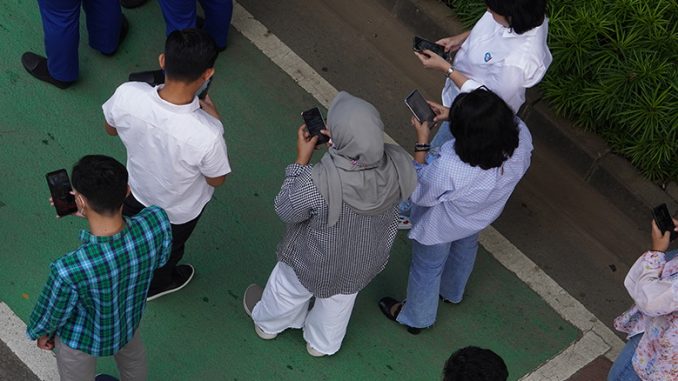
Digital technology and the internet have transformed the way we are living and how we are connected and interact, transcending physical boundaries. Despite its archipelagic geographical condition, Indonesian citizens are interconnected, seeing that at least 78.5 percent of Indonesia’s total internet user base uses at least one social media platform (Kemp, 2023). It also has transformed political participation in Indonesia. More than ever, citizens are enabled, if not encouraged, to voice their aspirations directly through social media. There will always be news, opinions, or stories to be shared and discussed daily at a rate that makes us wonder whether the discourses in these digital platforms are productive, much less meaningful.
Platforms of participation have changed
Digital participation opens up vast opportunities for people to be actively involved in voicing opinions in a virtual realm. It is even shaping the future trajectory of democracy that might be impossible in the analog sphere. At the same time, local governments have been trying to catch up with these digital trends. Indonesia, among other Asia-Pacific countries, has also experienced the “smart city boom” (Equinix, 2019), as evidenced by the varied digitalization applied by the municipalities to improve public services. The government’s social media channels and website are used for information dissemination and socialization of programs and regulations to reach a wider audience. With the number of digital platforms created by each local government as a result of building a smart city, one may wonder how effective are these government platforms in attracting the public to participate.
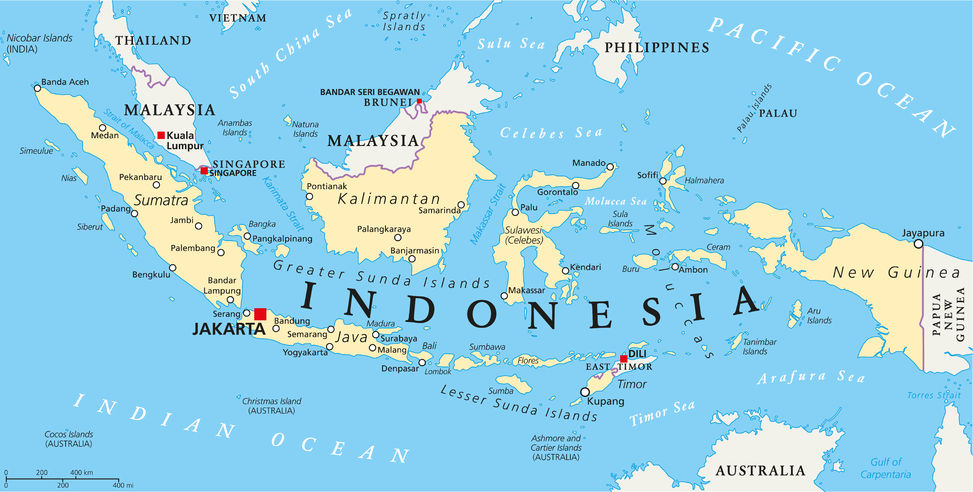
Undeniably, the rapid growth of digitalization and internet use have impacted transforming political participation in Indonesia. Even the central government went to the extent of establishing law 19/206 on information technology and electronic transactions (UU ITE), the first Indonesia law on information technology and digital, which raises debates and conflicts on the implementation due to its often being used to silence protests towards government and authorities. In early 2023, a young Tiktok content creator was reported to the police after publishing criticism of city development in Lampung Province on charges of ‘hate speech’ and the UU ITE violation. Although no criminal infringements were found and the young man has now been cleared, this is an example of one of many cases of using social media to convey aspirations, yet the restrictions remain in spaces that are supposed to allow freedom of speech.
Reflecting on how citizens and governments have leveraged digitalization as platforms of participation, to what extent have these efforts transformed how we interact with local governments and vice versa toward creating a better city for all?
Invited vs. invented space
In examining how urban governance has responded to the rapid growth of digital platforms, contrasting approaches to participation became apparent, bringing into light the concept of invited versus invented space.
Indonesian government incorporates the decentralization of governance, planning, and budgeting through a more bottom-up process called musrenbang (musyawarah perencanaan pembangunan). It is a participatory budgeting practice in Indonesia to formulate national and regional development plans, inviting academics, practitioners, communities, and citizens from the lower neighborhood level up to the city level to ensure the linkage between government programs and citizen needs. Musrenbang plays an integral part in promoting invited spaces for urban governance despite varied degrees of participation across the city.
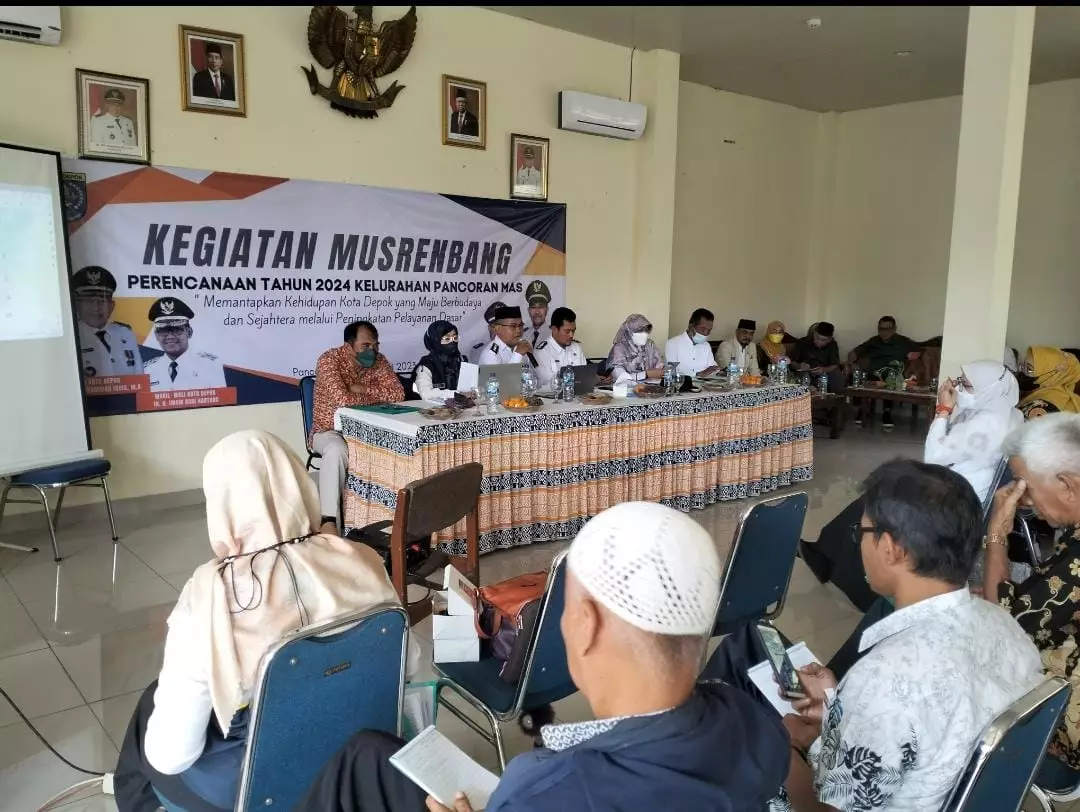
Selective participation has been apparent in some cities with different levels of flexibility in the selection procedures, with the most common reason being budget availability. Some cities with a strong culture of community gatherings, such as Surakarta, find a means to participate by accumulating a voluntary budget, donations, or corporate social responsibility (CSR) budget. Meanwhile, metropolitan cities with better infrastructures, such as Bandung and Surabaya, adopted technology to the forum and transformed it into e-musrenbang to encourage more civic engagement and promote transparency through leveraging digital technology.
As much as the public appreciates musrenbang, scepticism among them has become apparent. The forum is still seen as a symbolic process of participatory planning, where community involvement is formal, if not limited. It involves a segment of the community, an elite capture, often those aligned with the government’s agenda. As a result, the musrenbang may hinder community engagement and limit the representation of a broad spectrum of community voices. As for e-musrenbang, in practice the platform is seen as mere proof of municipalities adopting the smart city concept. The implementation has yet to be aligned with the initial purpose, and the platform’s sustainability is to be evaluated.
In response to the limitations of formal venues such as musrenbang, as well as the broader shift in the nature of political participation, particularly among young people, an insurgent approach to planning has arisen (Holston, 2014). Young individuals commonly participate in urban politics outside established government-led invited participation spheres. In Surakarta, Central Java, for example, a citizen forum (or Forum Kota) is set up informally to address developing issues or policies in the city. Their aspirations are channeled through social media, newspapers, or special events to raise awareness. It is even more common in large cities to find annual offline and online public discussions organized by local communities, ranging from housing, public transportation, and political issues to climate change’s impact on the city. These forums have enormous potential to keep citizens informed about concerns, increase their capacity to participate in urban discourses, and even co-shape the subject of conversation.
A platform that annually discusses urban discourse and is open to the public is the Urban Social Forum (USF). Since 2013, USF has been a platform that provides an open and inclusive space for exchanging knowledge, debating ideas, and networking between civil society organizations, activists, academics, and students working on pressing urban issues. Ultimately, the forum is a truly public and democratic space for people to put forward alternative ideas and imagine ‘Another City is Possible!’ This offline forum is an urban invented space that allows everyone to participate in the urban discourse of their interest.
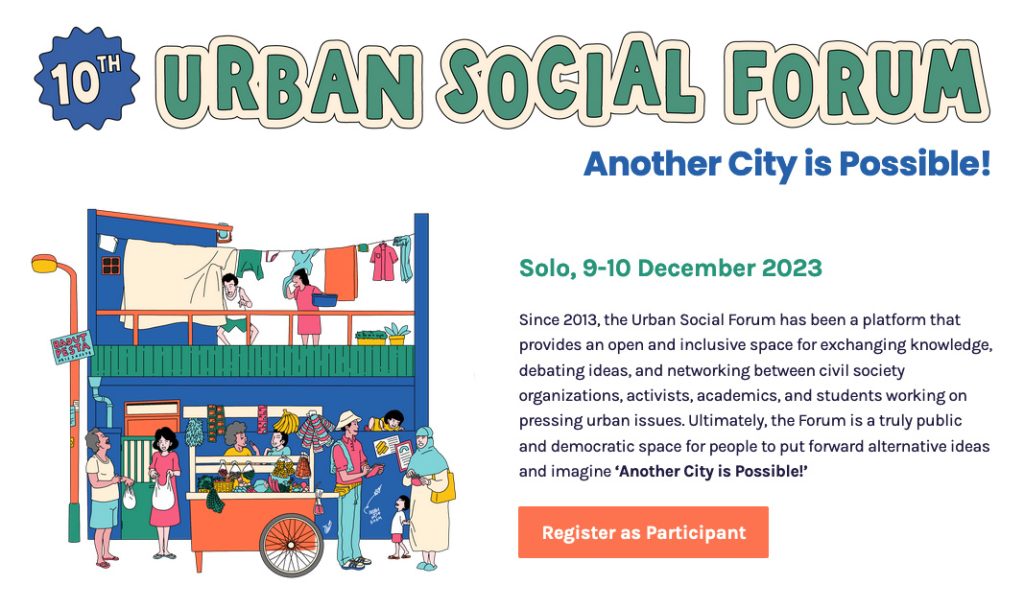
The invented space of participation, unfortunately, also comes with its drawbacks. There is growing concern about how to build a link between online activism and actual policymaking, which still primarily happens offline (Zhang, 2013). While digital platforms allow everyone to voice their concerns about urban development, the extent to which they will affect change in the real world is debatable. One of the best scenarios happened when Lentera Indonesia initiated an online petition in 2016 supporting the discussion and ratification of a Sexual Violence Crime Law by the Indonesian House of Representatives (Change.org, 2016). This petition was finally won, and after more than six years of advocacy, Indonesia ratified the law in 2022.
Unfortunately, this achievement is still uncommon, even for digital platforms created by the government. Several cities in Indonesia have citizen complaint service websites, but not all are followed up. The government should align these complaints with a city plan within a specific budget year, which takes a long time to process and requires the high political will of the governing mayor. This may lead to political cynicism (Kersting & Cronqvist, 2005) and even disengagement among citizens.
Observing all those phenomena, where should one stand in this contested cyberspace?
Co-producing meaningful actions
Digitalization has emphasized tensions between invited and invented spaces of participation, which has resulted in tokenistic participation. While the majority of Indonesian citizens have access to internet, with their different skills and social identities, we must be aware of possible exclusion the digital platform brings, bringing more complexities to platformization participation than meets the eye. Figuratively saying, for Lairana (a woman with a disability in eastern Indonesia, which is not yet covered by electricity and communication towers) or Kei (a non-binary who lives in a metropolitan whose identity has not yet been acknowledged by the state and experiences social stigma), participating in urban governance while considering the representativeness of their crossing identities is exceptionally perplexing, not to mention the digital aspect of it.
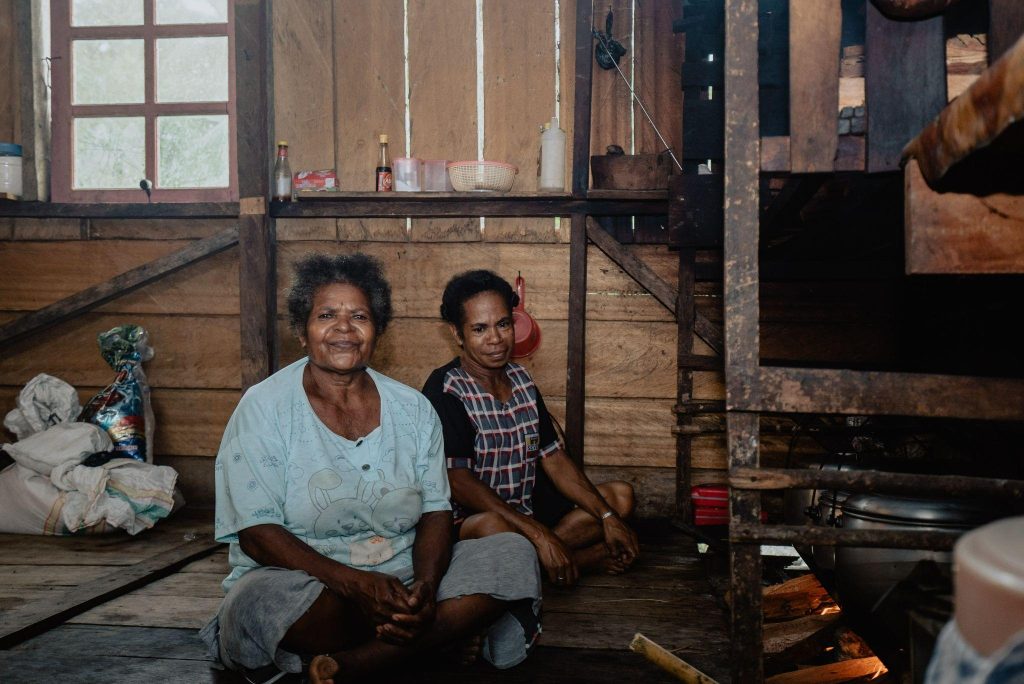
In terms of awareness, even though information circulates through news websites and social media, the citizen finds it more challenging to separate the truth, half-truth, and false ones because facts are blurred by government buzzers (Nugroho & Wihardja, 2023). Nevertheless, more insurgent, independent platforms led by young people emerged to counter popular narratives and bring out stories from the ground. Kolektif Agora, a medium to distribute ideas, debates, and citizen journalism, is an instance of encouraging freedom of expression in a saturated and strictly regulated mainstream media. Another platform, Bijak Memilih, was initiated by Think Policy and What Is Up Indonesia (WIUI) and led by a young woman to inform citizens about the agenda and political track records of presidential candidates and political parties supporting them.
Participation, however extricating it may sound, should be facilitated by the government if it were to make fundamental changes. Recalling the aforementioned regulation (UU ITE), digital technologies are not neutral tools but may reproduce exclusionary patterns, depending on how they are set up and governed (Polgar, 2010). Such a law makes Indonesian citizens self-censor their opinion before they make it available to the public because the fear of what happened with the previous TikTok content creator also happens to them. The repression often leads to dissatisfaction with urban development–how can cities provide what citizens need if their voices are being shut?
Reflecting on these issues, a more collaborative approach to designing platforms for participation should be envisioned, starting by fostering a shared understanding between citizens and government on how both currently and aspire to engage in the city-shaping process, their motivation, barriers, and enablers. Citizens must be empowered with the knowledge about their rights and responsibilities to the city. For instance, since 2015, Kota Kita Foundation has initiated a program called Urban Citizenship Academy, a hands-on educational experience empowering youth to develop meaningful solutions to real urban problems (kotakita.org) by enlightening young people about activism, citizenship, and advocacy tools as well as assisting them in initiating movement in a neighborhood or a city scale. At the same time, local government should improve their capacity to address the needs of citizens, including by creating platforms that meet citizen’s needs.
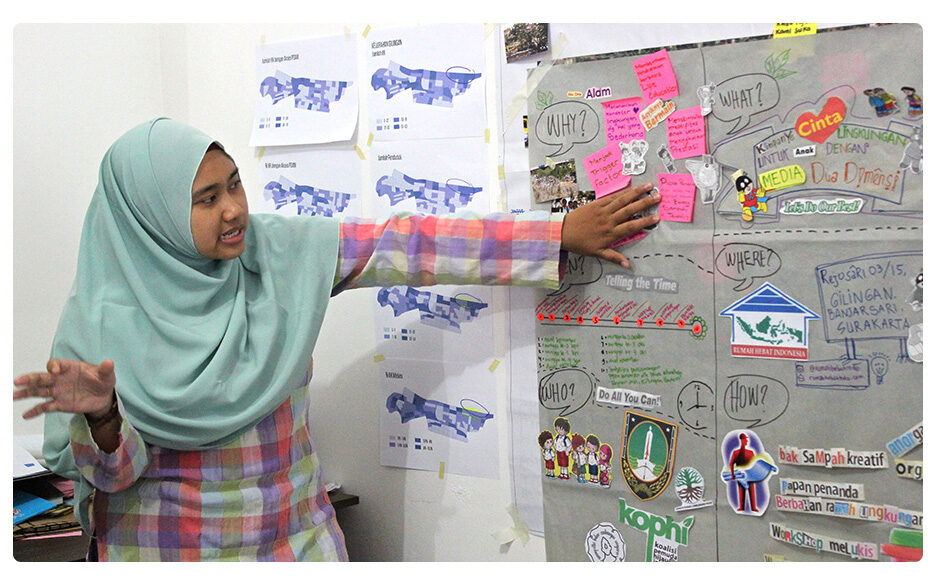
Further, collaboratively producing digital platforms between the government and citizens can generate trust and promote participation. More democratic innovations emerge, mixing conventional representative forms of participation with direct and deliberative participatory instruments. Additionally, it comes to a mix between offline and online instruments (Kersting, 2013). Participation should also be aligned with inclusivity, meaning that participation is not merely symbolic and exclusive to selected participants but recognizes the intersectionality of citizens (e.g., age, gender, ability, migration status). These should be supported by the government’s commitment, if not formalized through a policy, with solid enforcement to be adequately implemented.
Every citizen has the right to shape their city. Recognising the right to reclaim the city as a collective space would be essential for generating intentional discussion and advocacy in the city. By having informed and empowered citizens, it is possible to share a vision of a model city for all.
Asri Septarizky & Hasanatun Nisa Thamrin
Kota Kita Foundation, https://kotakita.org/
Banner: Jakarta, Indonesia – May, 2023: A number of people are using their smartphones on the streets of Jakarta. Abdlh Syamil, Shutterstock
References:
Change.org. (2016, May 3). Sahkan UU Penghapusan kekerasan Seksual. #MulaiBicara #GerakBersama. Retrieved from Change.org: https://www.change.org/p/dpr-ri-sahkan-uu-penghapusan-kekerasan-seksual-mulaibicara
Equinix Editor. (2019, May 6). Why Are Smart Cities Booming in Asia Pacific? Retrieved from Equinix Interconnections: https://blog.equinix.com/blog/2019/05/06/why-are-smart-cities-booming-in-asia-pacific
Holston, J. (2014). ‘Come to the Street! Urban Protest, Brazil 2013’, Anthropological Quarterly, Vol. 87, No. 3, pp. 887-900.
Kemp, S. (2023, February 9). Digital 2023: Indonesia. Retrieved from Data Reportal: https://datareportal.com/reports/digital-2023-indonesia
Kersting, N. (2013) ‘Online participation: from ‘invited’ to ‘invented’ spaces’, Int. J. Electronic Governance, Vol. 6, No. 4, pp.270–280
Nugroho, Y., & Wihardja, M. M. (2023, October 9). Preventing Indonesia’s “Digitalised” Democracy from Backsliding. Retrieved from Fulcrum: Analysis on Souteast Asia: https://fulcrum.sg/preventing-indonesias-digitalised-democracy-from-backsliding/
Zhang, W. (2013). Redefining youth activism through digital technology in Singapore. In Digital Activism in Asia Reader edited by Nishant Shah, Puthiya Purayil Sneha, and Sumandro Chattapadhyay, Meon Press, Luneberg, 235 – 256
